A global survey points out how an open library of XR resources could fill a longstanding gap in immersive educational simulation resources.

The OEXR Opportunity
The landscape of open educational resources (OER) is remarkably diverse, yet extended reality (XR)—encompassing augmented, mixed, and virtual reality modalities—has remained largely absent from the OER community. Recent technological advancements, reduced hardware costs, and a growing array of available content have accelerated XR adoption. Additionally, a small but growing body of literature has demonstrated the effectiveness of XR tools for learners. Thus, an opportunity exists to meet the growing demand for XR content by leveraging the OER model through democratized creation and utilization. To address this need, a multi-institutional and interdisciplinary collaboration emerged through the EDUCAUSE XR Community Group to develop a shared resource dubbed the Open Educational Extended Reality (OEXR) Library.
OEXR History
The OEXR Library was conceptualized to address a key bottleneck for the adoption of XR in the classroom by empowering faculty and technologists to quickly discover content ranging from full, off-the-shelf experiences to modules and assets that can be used in custom software alongside pedagogical guidance for sound deployment. The idea for the OEXR Library first emerged through a project featured in the 2021 EDUCAUSE Horizon Report | Teaching and Learning Edition highlighting a virtual anatomy library that was developed through the San Diego State University (SDSU) Virtual Immersive Teaching and Learning (VITaL) Research Center, followed by a presentation at the 2022 EDUCAUSE Learning Initiative Annual Meeting by North Carolina State University (NCSU) and SDSU titled "Open Educational eXtended Reality (OEXR): Why Now?"
The library started as a resource to empower an SDSU anatomy instructor to continue teaching despite having developed a severe sensitivity to formaldehyde. Photogrammetry—a process that triangulates points within overlapping composite photos to create three-dimensional modelsFootnote1—was used to develop a library of 3D models of bones and soft tissues as an alternative for the instructor (see figure 1), and this work also benefited pregnant women and other students who could not to be in contact with formaldehyde. In March 2020, this library suddenly became a key resource to all SDSU students during the rapid transition to virtual instruction with the onset of the global pandemic. When the concept emerged of making the hundreds of models available to the more than 450,000 students across the California State University system, the model for the OEXR Library was born. Similar efforts have been carried out in parallel at other institutions, including NCSU; however, there has not been a mechanism to link these resources into one comprehensive library.
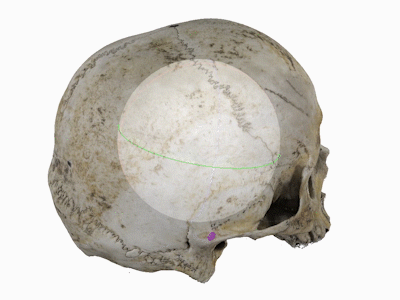
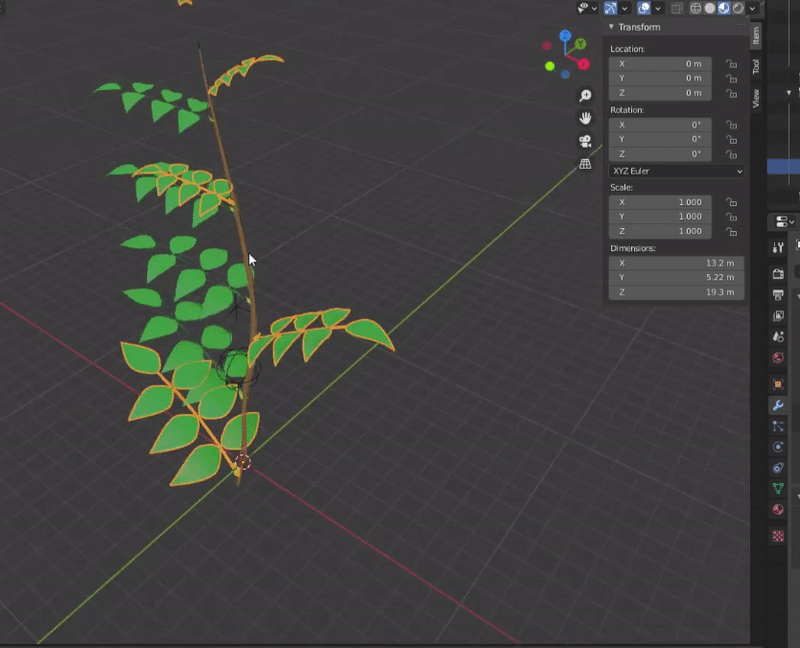
Since these early libraries emerged, broad interest has developed in creating an interdisciplinary resource across higher education communities, including within the EDUCAUSE XR Community Group. In fall 2023, a subcommittee was established to conduct a formal needs analysis for the development of the OEXR Library. As part of this process, a survey instrument was developed to capture and rank functionality criteria to ensure that the OEXR Library is designed to be a resource for the collective higher education community, aiming to democratize transformative XR technology and ensure equitable access for all. The survey instrument was tailored to inform the design of the OEXR Library functionality to cater to diverse user needs, ranging from contributors to consumers. The survey was then distributed globally via the EDUCAUSE XR Community Group in spring 2024 and was followed by a series of focus group discussions at Fresno State University.
Worldwide Reach
The survey respondents (n = 169) represented 100 institutions across six continents, largely from the United States and Canada but also from Austria, France, Kazakhstan, Peru, South Africa, Turkey, and the West Indies (see figure 2). The survey had an 18% response rate from the 961 EDUCAUSE XR Community Group members to whom the survey was distributed.

Survey participants primarily consisted of faculty (n = 52), administrators (n = 50), and staff (n = 49), with additional input from librarians (n = 8), students (n = 3), and industry partners (n = 7). Institutions included doctoral universities (R1 and R2), master's universities (M1), baccalaureate colleges (BC), associate's colleges (AC), and K–12 school districts (SD), as well as a variety of special focus (SF) and other institutions (see figure 3).

Focus group sessions were conducted at the Supporting Active Learning in Introductory STEM Courses with Extended Reality 2024 Summer Symposium, hosted at Fresno State University and supported by the NSF. Focus groups consisted of faculty members (n = 25), students (n = 24), administrators (n = 10), and staff (n = 7) from the California State University Chancellor's Office, Clovis Community College, Fresno City College, Fresno State University, San Diego State University, San José State University, and Sonoma State University, as well as two industry partners.
Survey Results
The survey covered areas including usage, conbributions to an XR library, features and functions, and access.
XR and OER Usage
The majority of respondents (67%) were experienced active users of XR technology, consisting of new XR users within the past year (n = 23) and experienced active users for over a year (n = 91) (see figure 4). This indicates a strong foundational knowledge base within the community, with many institutions already exploring or planning to explore XR applications in their educational practices. A smaller group of respondents (25%) planned to start implementing XR in the near future (n = 17) or were in the process of investigating implementation (n = 25). The remainder of respondents (8%) found XR intriguing but were unsure of how it fits within their institution (n = 13).
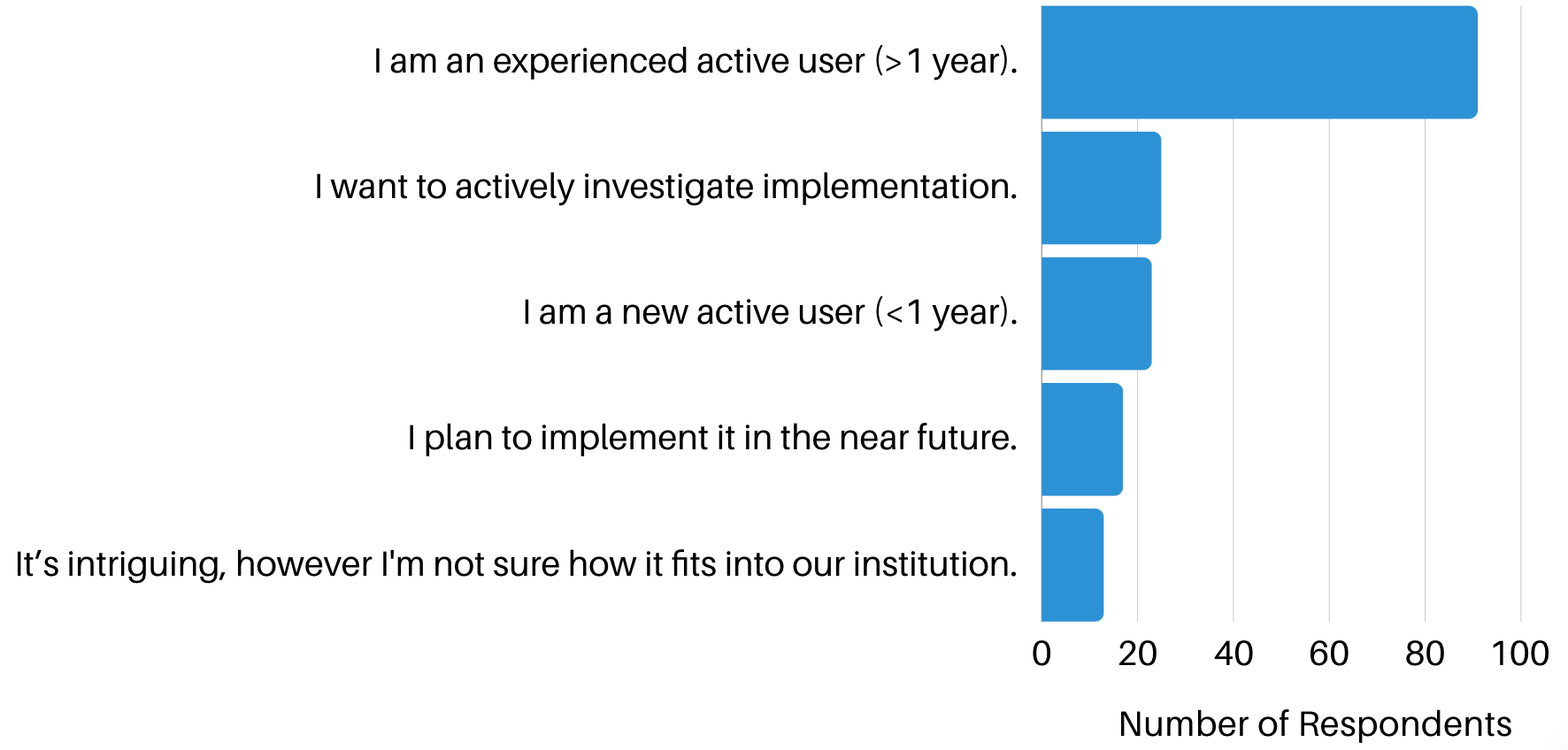
When asked about prior use of OER repositories, 58% (n = 98) of respondents indicated they had previously used popular repositories, including OER Commons, MERLOT, and Canvas Commons. The survey results indicated a strong supply of XR content contribution, with 54% of respondents indicating their institutions would contribute content, while 43% of respondents were unsure if their institutions would be willing to contribute content (see figure 5). Feedback from the focus group participants indicated that this uncertainty is due to limited institutional support—particularly at institutions that have historically underserved populations of first-generation and low-income students—thereby reinforcing the importance of making XR content openly available across institutions. Only 3% (n = 5) indicated that their institution would not be able to contribute content to the library.

Functionality Priorities
When it comes to the functionality features that respondents indicated were most important for the OEXR Library, three key areas emerged as top priorities: accessibility, discoverability, and quality assurance (see figure 6). These functionality priorities formed the foundation on which the OEXR Library framework was established.

The first area emerging as a top priority is accessibility. Ensuring the OEXR Library is accessible to all users, including those with disabilities, is paramount. Respondents overwhelmingly advocated for incorporating features like desktop versions (n = 133), captions (n = 106), screen readers (n = 79), and Equally Effective Alternative Access Plans (EEAAPs) (n = 75) (see figure 7). Survey participants highlighted the need for guidelines to ensure accessibility: "Make it widely accessible" and "make it easy to use even for those who do not have a technical coding background." Focus group discussions emphasized that "guidelines for accessibility including vision and hearing impaired as well as epilepsy" are crucial.
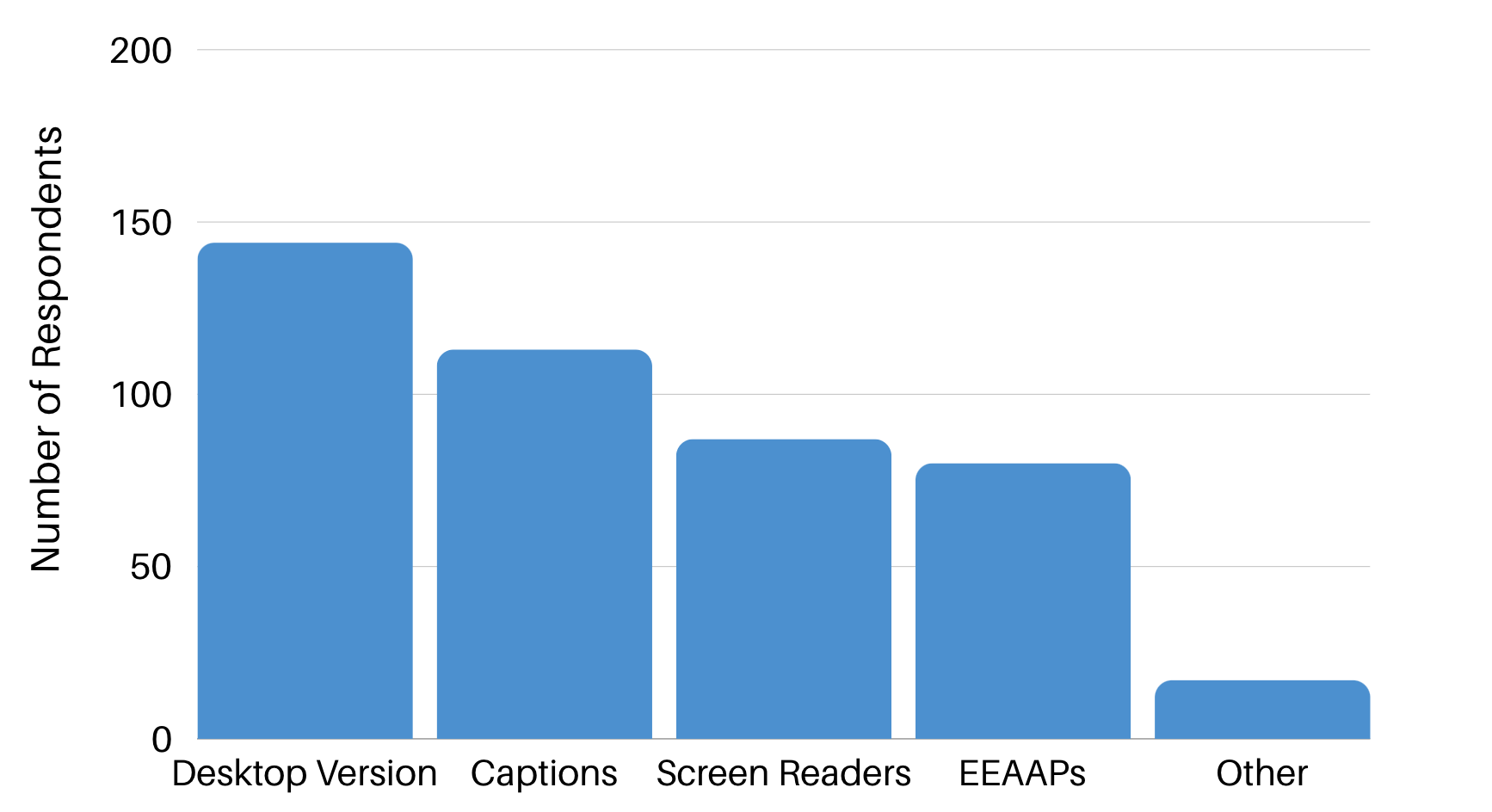
The second top priority is discoverability. Enhanced discovery mechanisms and robust tagging systems were also noted as priorities, allowing content to be categorized and tagged based on multiple criteria, such as discipline and media type. One respondent mentioned the necessity of "search functionality and the ability to preview models in 3D," underscoring the importance of finding and accessing high-quality resources quickly. Interactive downloadable assets available in multiple formats and compatible with various platforms were also deemed essential to ensure seamless integration into existing curricula. Additionally, pedagogical support resources, such as learning objectives and assessment suggestions—as well as integration with other emerging technologies, such as generative artificial intelligence—were noted as areas of interest that could enhance the OEXR Library's capabilities.
The third top priority is quality assurance. Respondents emphasized the need for their institution to develop and customize content to address learning outcomes, prioritize accessibility, and ensure openness, which can be challenging with commercial options. However, some respondents expressed uncertainty about their institution's ability to create and contribute high-quality content, which they described using terms such as "photorealistic" and "interactive." This highlights the need for comprehensive contributor guides, including suggestions from respondents for guides on "how to create 3D content using photogrammetry" or "developing a lesson plan for how to use XR resources." These guidelines would help establish a model for the quality and consistency of submissions, making it easier for institutions to contribute valuable resources.
Content Contribution and Utilization
Respondents overwhelmingly indicated that resources in the OEXR Library must be compatible with various XR formats and systems, ensuring that content can be used seamlessly across different ecosystems. This includes desktop versions, 3D models, 360-degree videos, VR apps, and AR apps. Respondents stressed the importance of "support for multiple XR platforms/ecosystems" and "integration with WebXR [a web application programming method that provides access to augmented reality and virtual reality devices in a web browser] functions." Additional comments referenced adherence to interoperability standards, noting that "ensuring that assets follow OpenUSD [an open-source framework for collaboratively developing 3D content] could help in the future with support for multiple ecosystems."
The survey revealed insights into the relationship between content contribution and utilization across different XR content categories, highlighting areas where supply and demand are not aligned and identifying opportunities for the OEXR Library to bridge these gaps (see figure 8). For 3D models, for example, the demand significantly exceeds the supply. This disparity indicates a clear opportunity for the OEXR Library to facilitate the creation and sharing of 3D models to meet the substantial demand from educators and institutions. Because these resources are digital, however, content can be effectively scaled, replicated, and reused across various educational contexts, thereby meeting demand without being constrained by the initial volume of contributions.
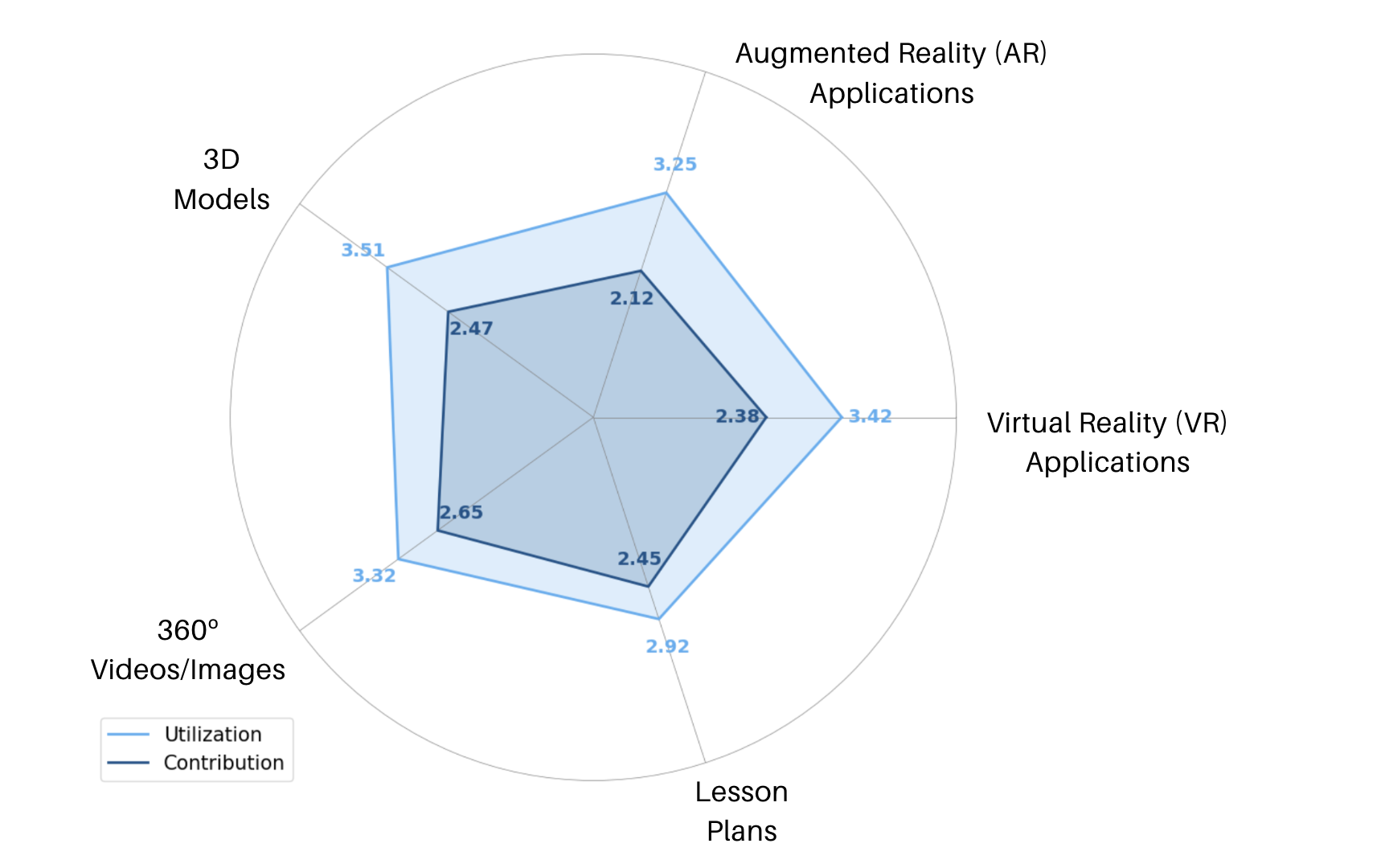
Engagement and Open Collaboration
Building a vibrant community around the OEXR Library emerged as essential for its success. This involves fostering collaboration, sharing effective practices, and engaging users in continuous feedback loops. Survey respondents underscored the value of a collaborative community: "Having a 'community' group to discuss and share the usage of the objects in the library would be valuable." Focus group participants echoed this sentiment, emphasizing the necessity of institutional support and collaboration, as well as fostering collaboration between faculty and students.
The flexibility afforded by the 5Rs of OER—the ability to Reuse, Remix, Revise, Redistribute, and Retain contentFootnote2—proved to be a critical priority for users to adapt materials to specific teaching contexts, fostering innovation and personalized learning experiences. Additionally, a focus on facilitating XR research within the OEXR Library emerged, including fostering research replication and scholarship of teaching and learning (SoTL). As one survey respondent indicated, empirical research is a key element in order to continue to build on the body of literature measuring XR's "impact to enhancing education vs. nice-to-have bell or whistle."
Development collaboration and authorship recognition also emerged as key to encouraging a collaborative ethos in which users actively contribute to and benefit from the collective knowledge. Structured mechanisms for feedback—such as a networking directory, peer reviews, and a citation tracker—were requested as mechanisms to facilitate connections, share best practices, and enhance the credibility of the library's resources. Integrating these strategies, many of which can be repurposed from existing open source and open culture practices, would ensure that the OEXR Library serves as a dynamic, valuable, and inclusive resource for educators and learners alike.
Importance of Free Access for All Users Globally
A substantial majority of survey respondents (n = 138) indicated that free access to the OEXR Library for all users is crucial, underscoring the diverse range of institutions participating in our survey. Additionally, focus group participants reiterated the importance of "ensuring equitable access to XR tools and resources" such that institutions with limited financial resources can still benefit from XR technologies. Respondents indicated that any form of paid access could significantly limit the reach and impact of the OEXR Library. By maintaining free access, the library can support a wide array of educational institutions, irrespective of any resource contraints, thereby fostering inclusivity and democratizing access to cutting-edge XR educational tools. As one participant mentioned, the OEXR content will be "applicable to countries all over the world and not just the USA, UK, etc." Therefore, this approach not only supports the diverse needs of global users but also aligns with the core OER principles, which advocate for freely accessible and openly licensed educational materials for everyone.
Toward an OEXR Library
The survey data and focus group insights indicate a strong demand for the creation of an OEXR Library and reinforce the necessity for institutions to develop and share their XR content, underscoring the importance of providing detailed contributor guides. To guide the design and development of the OEXR Library, the conceptual framework shown in figure 9 was developed using the themes that emerged around the areas of contribution, functionality, and engagement. This framework will be used to guide the design, development, and deployment of the OEXR Library, and it will influence the ongoing governance within the OEXR community.
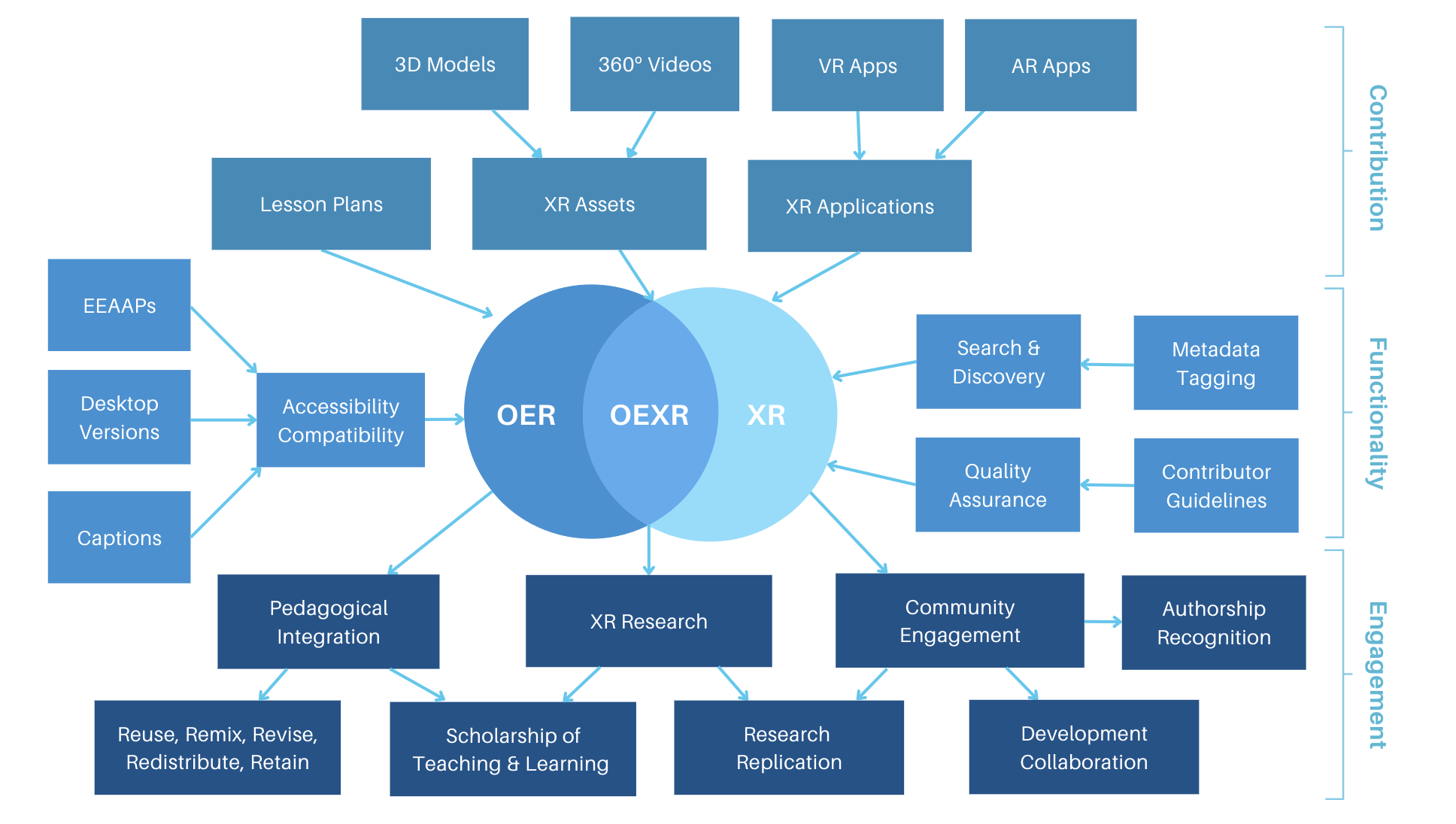
The contribution section of the framework is designed to foster a collaborative environment by enabling institutions and individuals to contribute a diverse range of XR assets, including 3D models, 360-degree videos, XR applications, and lesson plans. With the goal of democratizing access to XR tools, the library design will prioritize the creation and sharing of these high-demand resources. These XR assets and applications will be accompanied by lesson plans that include strategies for deployment and assessment across various educational contexts, fostering a culture of shared knowledge and resources.
The functionality section is designed to cater to a broad audience, emphasizing accessibility compatibility, search and discovery functionality, and quality assurance. Accessibility is prioritized by enabling the sharing of complementary resources, such as EEAAPs and alternative formats. Enhanced search and discovery functionality is achieved through robust metadata tagging systems, allowing users to easily find and preview XR content. Quality assurance is maintained through comprehensive contributor guidelines that help institutions develop and customize content to meet learning outcomes and accessibility standards. These functionality priorities ensure that the OEXR Library is user friendly, efficient, and capable of supporting a wide range of users across educational contexts.
Finally, the engagement section is intended to foster a collaborative community focused on pedagogical integration, XR research, and community engagement. The flexibility of the 5Rs of OER supports personalized learning experiences and SoTL. XR research is promoted through SoTL and research replication efforts. Community engagement is enhanced by encouraging research and development collaborations and by providing authorship recognition. These strategies ensure that the OEXR Library will serve as a dynamic, valuable, and inclusive resource for educators and learners alike, fostering continuous improvement and innovation in the use of XR in education.
Next Steps
To advance the OEXR Library, the EDUCAUSE XR Community Group is in the process of soliciting innovative solutions and partnerships to carry out the vision that emerged through the framework. The Community Group will evaluate potential technology solutions in a process similar to an RFP, with criteria informed by the goals of the OEXR Library and the requirements for accessibility, content quality, and compatibility standards outlined in the research. The process will also emphasize the need for user-friendly interfaces and robust discovery capabilities. By inviting demos from a diverse range of developers, educators, and industry partners, the process will be designed to identify the best solutions to meet the needs of the OEXR community. This approach will also encourage competition and innovation, leading to the development of a more effective and comprehensive XR library.
Responding to the community's desire for a platform and content that remain broadly accessible to individuals and institutions with fewer resources is less straightforward than selecting a technology solution. Creating and maintaining the OEXR Library's platform will require an ongoing commitment of support from institutions able to dedicate resources to creating a community good. More critical, though, is the ongoing fostering of community relationships that encourage creators to share their work, apply lessons learned, and mentor new adopters as they explore an emerging set of technologies and experiences. Simultaneous with reviewing technology solutions, the EDUCAUSE XR Community Group will seek responsible collaboration examples and guidance to encourage the OEXR Library's community as a sustainable, self-guided resource.
The OEXR Library aims to democratize academic XR usage and development resources, ensuring equitable access across institutions. By addressing the identified needs, leveraging the collective resources of the higher education community, and collectively evaluating solutions to drive development and collaboration, the OEXR Library can become a pivotal resource in enhancing learning experiences. News of the OEXR Library will be shared via the EDUCAUSE XR Community Group webpage and monthly meetings. In the meantime, we encourage you to explore the survey responses via the OEXR Survey Data Dashboard.
Acknowledgments
This effort would not have been possible without the survey respondents and the focus group participants or the exceptional contributions of our research assistants at Drexel University and San Diego State University: Shweta Chauhan, Tanvayee Dhawale, Nicholas Ishizaka, Mahdieh Molaei, Thai Nguyen, and Harshool Rokade. Their dedication and hard work were instrumental in the data collection and analyses, which were led by the EDUCAUSE XR Community Group through the OEXR subcommittee, which comprised the following members:
|
Name |
Title |
Organization |
|---|---|---|
| John Bell (OEXR Subcommittee Co-Chair) | Director, Magnuson Studios | Dartmouth College |
| Joseph Doan | Immersive Reality Lab Coordinator, Library Technology Services | Texas A&M University-Corpus Christi |
| Sean Hauze (OEXR Subcommittee Co-Chair & XR Community Group Co-Lead) | Senior Director, Instructional Technology | San Diego State University |
| Kate Miffitt | Senior Director, Innovation, Digital Experience & Accessibility | California State University Office of the Chancellor |
| Brandon Patterson | Technology Engagement Librarian, Eccles Health Sciences Library | University of Utah |
| Hector Revollo | Instructional Technologist & XR Technology Specialist | Northern Virginia Community College |
| Randall Rode (XR Community Group Co-Lead) | Education Strategy Consultant; XR/VR/AR specialist | Rodeworks |
| Jeannine Shantz | Director, Research, Evaluation & Assessment, Charles D. Close School of Entrepreneurship | Drexel University |
| James Trotter | Director, Multimedia & Immersive Technologies | California State University, San Bernardino |
| David Woodbury | Head, Learning Spaces & Services, NC State University Libraries | North Carolina State University |
Notes
- Steve Nebel, Maik Beege, Sascha Schneider, and Günter Daniel Rey, "A Review of Photogrammetry and Photorealistic 3D Models in Education From a Psychological Perspective," Frontiers in Education 5 (August 6, 2020). Jump back to footnote 1 in the text.
- David Wiley, T. J. Bliss, and Mary McEwen, "Open Educational Resources: A Review of the Literature," in Handbook of Research on Educational Communications and Technology, eds. J. Michael Spector, M. David Merrill, Jan Elen, and M. J. Bishop (New York: Springer Science+Business Media, 2014), 781–789. Jump back to footnote 2 in the text.
Sean Hauze is Senior Director, Instructional Technology, at San Diego State University.
© 2024 Sean Hauze. The content of this work is licensed under a Creative Commons BY 4.0 International License.
